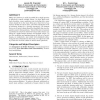Free Online Productivity Tools
i2Speak
i2Symbol
i2OCR
iTex2Img
iWeb2Print
iWeb2Shot
i2Type
iPdf2Split
iPdf2Merge
i2Bopomofo
i2Arabic
i2Style
i2Image
i2PDF
iLatex2Rtf
Sci2ools
HRI
2007
ACM
2007
ACM
Developing performance metrics for the supervisory control of multiple robots
Efforts are underway to make it possible for a single operator to effectively control multiple robots. In these high workload situations, many questions arise including how many robots should be in the team (Fan-out), what level of autonomy should the robots have, and when should this level of autonomy change (i.e., dynamic autonomy). We propose that a set of metric classes should be identified that can adequately answer these questions. Toward this end, we present a potential set of metric classes for human-robot teams consisting of a single human operator and multiple robots. To test the usefulness and appropriateness of this set of metric classes, we conducted a user study with simulated robots. Using the data obtained from this study, we explore the ability of this set of metric classes to answer these questions. Categories and Subject Descriptors J.7 [Computers in Other Systems]: Command and Control; H.5.2 [User Interfaces and Presentation]: Evaluation/methodology General Terms M...
Related Content
| Added | 16 Aug 2010 |
| Updated | 16 Aug 2010 |
| Type | Conference |
| Year | 2007 |
| Where | HRI |
| Authors | Jacob W. Crandall, M. L. Cummings |
Comments (0)

